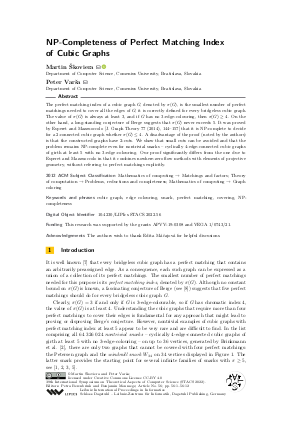NP-Completeness of Perfect Matching Index of Cubic Graphs
Authors
Martin Škoviera  ,
Peter Varša
,
Peter Varša
-
Part of:
Volume:
39th International Symposium on Theoretical Aspects of Computer Science (STACS 2022)
Part of: Series: Leibniz International Proceedings in Informatics (LIPIcs)
Part of: Conference: Symposium on Theoretical Aspects of Computer Science (STACS) - License:
 Creative Commons Attribution 4.0 International license
Creative Commons Attribution 4.0 International license
- Publication Date: 2022-03-09
File

PDF
LIPIcs.STACS.2022.56.pdf
- Filesize: 0.77 MB
- 12 pages
Document Identifiers
Subject Classification
ACM Subject Classification
- Mathematics of computing → Matchings and factors
- Theory of computation → Problems, reductions and completeness
- Mathematics of computing → Graph coloring
Keywords
- cubic graph
- edge colouring
- snark
- perfect matching
- covering
- NP-completeness
Metrics
- Access Statistics
-
Total Accesses (updated on a weekly basis)
0Document
0Metadata
Abstract
The perfect matching index of a cubic graph G, denoted by π(G), is the smallest number of perfect matchings needed to cover all the edges of G; it is correctly defined for every bridgeless cubic graph. The value of π(G) is always at least 3, and if G has no 3-edge-colouring, then π(G) ≥ 4. On the other hand, a long-standing conjecture of Berge suggests that π(G) never exceeds 5. It was proved by Esperet and Mazzuoccolo [J. Graph Theory 77 (2014), 144-157] that it is NP-complete to decide for a 2-connected cubic graph whether π(G) ≤ 4. A disadvantage of the proof (noted by the authors) is that the constructed graphs have 2-cuts. We show that small cuts can be avoided and that the problem remains NP-complete even for nontrivial snarks - cyclically 4-edge-connected cubic graphs of girth at least 5 with no 3-edge-colouring. Our proof significantly differs from the one due to Esperet and Mazzuoccolo in that it combines nowhere-zero flow methods with elements of projective geometry, without referring to perfect matchings explicitly.
Cite As Get BibTex
Martin Škoviera and Peter Varša. NP-Completeness of Perfect Matching Index of Cubic Graphs. In 39th International Symposium on Theoretical Aspects of Computer Science (STACS 2022). Leibniz International Proceedings in Informatics (LIPIcs), Volume 219, pp. 56:1-56:12, Schloss Dagstuhl – Leibniz-Zentrum für Informatik (2022)
https://doi.org/10.4230/LIPIcs.STACS.2022.56
BibTex
@InProceedings{skoviera_et_al:LIPIcs.STACS.2022.56,
author = {\v{S}koviera, Martin and Var\v{s}a, Peter},
title = {{NP-Completeness of Perfect Matching Index of Cubic Graphs}},
booktitle = {39th International Symposium on Theoretical Aspects of Computer Science (STACS 2022)},
pages = {56:1--56:12},
series = {Leibniz International Proceedings in Informatics (LIPIcs)},
ISBN = {978-3-95977-222-8},
ISSN = {1868-8969},
year = {2022},
volume = {219},
editor = {Berenbrink, Petra and Monmege, Benjamin},
publisher = {Schloss Dagstuhl -- Leibniz-Zentrum f{\"u}r Informatik},
address = {Dagstuhl, Germany},
URL = {https://drops.dagstuhl.de/entities/document/10.4230/LIPIcs.STACS.2022.56},
URN = {urn:nbn:de:0030-drops-158667},
doi = {10.4230/LIPIcs.STACS.2022.56},
annote = {Keywords: cubic graph, edge colouring, snark, perfect matching, covering, NP-completeness}
}
Author Details
Funding
This research was supported by the grants APVV-19-0308 and VEGA 1/0743/21.
Acknowledgements
The authors wish to thank Edita Máčajová for helpful discusions.
References
-
M. Abreu, T. Kaiser, D. Labbate, and G. Mazzuoccolo. Treelike snarks. Electron. J. Combin., 23:#P3.54, 2016.

-
G. Brinkmann, J. Goedgebeur, J. Hägglund, and K. Markström. Generation and properties of snarks. J. Combin. Theory Ser. B, 103:468-488, 2013.

-
L. Esperet and G. Mazzuoccolo. On cubic bridgeless graphs whose edge-set cannot be covered by four perfect matchings. J. Graph Theory, 77:144-157, 2014.

-
I. Holyer. The NP-completeness of edge-coloring. SIAM J. Comput., 10:718-720, 1981.

-
E. Máčajová and M. Škoviera. Cubic graphs that cannot be covered with four perfect matchings. J. Combin. Theory Ser. B, 150:144-176, 2021.

-
B. Mohar and C. Thomassen. Graphs on Surfaces. Johns Hopkins University Press, 2001.

-
J. Plesník. Connectivity of regular graphs and the existence of 1-factors. Mat. Čas., 22:310-318, 1972.

-
P. D. Seymour. On multi-colourings of cubic graphs, and conjectures of Fulkerson and Tutte. Proc. London Math. Soc., 38:423-460, 1979.

-
E. Steffen. 1-Factor and cycle covers of cubic graphs. J. Graph Theory, 78:195-206, 2015.

